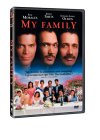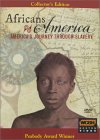|
|
|||||
|
|
|
|
|||
|
|
KariSable.com recommends: Daughter From Danang -- A mix of epic history and intimate family portrait, the reunion of a Tennessee woman, Heidi, with her Vietnamese mother and siblings after 22 years. Shipped to the U.S. in the waning days of the Vietnam war, Heidi--formerly Mai Thi Hiep--was the daughter of a white American soldier and a Danang woman abandoned by her Viet Cong husband. Fearing reprisals against Amerasian children, Hiep's mother, despite unbearable pain, gave Hiep to an adoption agency. Raised by an abusive woman in Pulaski (birthplace of the KKK), Hiep/Heidi kept her full heritage secret. This episode of PBS's American Experience follows Heidi's journey home: There is sorrow, joy, and relief, of course, but also a slow-brewing uneasiness as cultures collide. As raw expectations of her impoverished, Third World family begin to grate on Heidi, the burden of carrying two national destinies becomes comically and tragically oversized in the poor woman's shoes. The Human Stain -- Given the formidable challenge of adapting Philip Roth's acclaimed novel to the screen, it's a wonder that The Human Stain retains so much of what makes Roth's novel a masterpiece. As adapted by Nicholas Meyer, Robert Benton's film is inevitably a different animal altogether, and it's wide open to charges of miscasting and thematic diffusion. But at its core, this delicate drama succeeds in exposing the sins that stain all of humanity, forcing men like former welterweight boxer and esteemed professor Coleman Silk (Anthony Hopkins) to forsake family and career to conceal his African American heritage. Light-skinned and passing as a Jewish professor of classics in a tony East Coast college, 71-year-old Silk sinks into scandal when an innocent remark is misinterpreted as a racist slur, and this--along with his affair with an illiterate 34-year-old janitor (Nicole Kidman), and friendship with a reclusive novelist (Gary Sinise)--forms the crux of Benton's multilayered inquiry into the oppressive aftershocks of guilt, shame, and mourning, and the effects of judgment (internal and external) on our ability to connect. Roth's novel was one thing, Benton's film is another. Despite differing degrees of success, both are worthy of praise. --Jeff Shannon Francis Ford Coppola's three-generational immigrant saga of the Sanchez family. During the 1920's a young Hispanic man, Jimmy Sanchez (Edward James Olmos), walks from revolutionary Mexico to America back when the the border was just a line in the dirt. His journey on foot took an entire year. He joined an elder relative who had lived in East Los Angeles, CA since it was part of Mexico and it was in this home the family was raised. This movie spans the life of the patriarch who walked to America, through the depression and a wars raising three generations of Mexican Americans. Get ready to dive into one of the most violent, drug-infested neighborhoods only to see it transform into the trendy, residential enclave it has become. Many of the old timers figured out how to survive the area when it was a ghetto - now the challenge for them is to see if they can survive gentrification. 7TH STREET draws the viewer into a neighborhood that most people were once too afraid to enter. An area that most people only heard rumors about: Alphabet City in NYC's East Village, once known as the drug capital of the East Coast. The movie explores change in one of the most vital areas of NYC and the complexity of gentrification. Not only is this movie about one block in Manhattan - it's about neighborhoods and communities all over the world where progress sometimes comes at the expense of richness of character and diversity. Viewers join in Pais' struggle as he sees his block transform and become a safe place for his newborn son and a trendy neighborhood for the new inhabitants at the expense of his street family. The people who were his role models as a child he now sees homeless in Tompkins Square Park or discovers them dead. In 1935, an 8-year-old orphaned boy is sent to live in the Tennessee mountains with his grandparents. He doesn't yet know that he is half Cherokee, on his grandmother's side. As he learns about life and the Cherokee "way" from his grandparents, Little Tree's sensitivity to nature and to others grows. Little Tree becomes close to a Cherokee who tells him about the Trail of Tears. When the government places Little Tree in an Indian school, he is abused physically and psychologically, the issue of the forced assimilation of Native Americans isn't glossed over. Excellent performances make this well worth watching with children ages 8 and up. Forrest Carter, who wrote the book the movie is based on, was a one-time KKK member and speechwriter for George Wallace. It's hard to imagine how a former white supremacist could write such a moving tale about racism. --Elisabeth Keating Once Upon a Time When We Were Colored Tim Reid's wonderful film about life in the black neighborhood of Glen Allan, Mississippi, from the mid-'40s to the dawn of the civil rights movement, is thick with terrific, inspired actors and possessed of a mature, limpid visual style. The story is told from the point of view of a young boy raised by his stalwart grandfather and his kind aunt. But the collective tale of a community coming to terms with the risks it must take to fight racism and achieve political rights is equally important and compelling. Beautifully written (based on the autobiographical novel by Clifton Taubert), Reid's vision is rich in scenes of ritual and community that have rarely, if ever, been revealed on film. This is more than just a good movie; it's a watershed event in this nation's cultural history. --Tom Keogh
The 1993 film adaptation of Amy Tan's bestselling novel is an anthology of stories wrapped in one Chinese-American woman's journey to understand her roots through eight tales of the lives of Chinese women, most of them set in the past. The script is a delicate balance of emotions that brings a personal feel of daily life in the Chinese-American community.
May 31, 2004 PLEASE CONTRIBUTE TODAY!Kari & Associates Copyright Kari Sable 1994-2006 |






 In America
In America Daniel Deronda
Daniel Deronda

